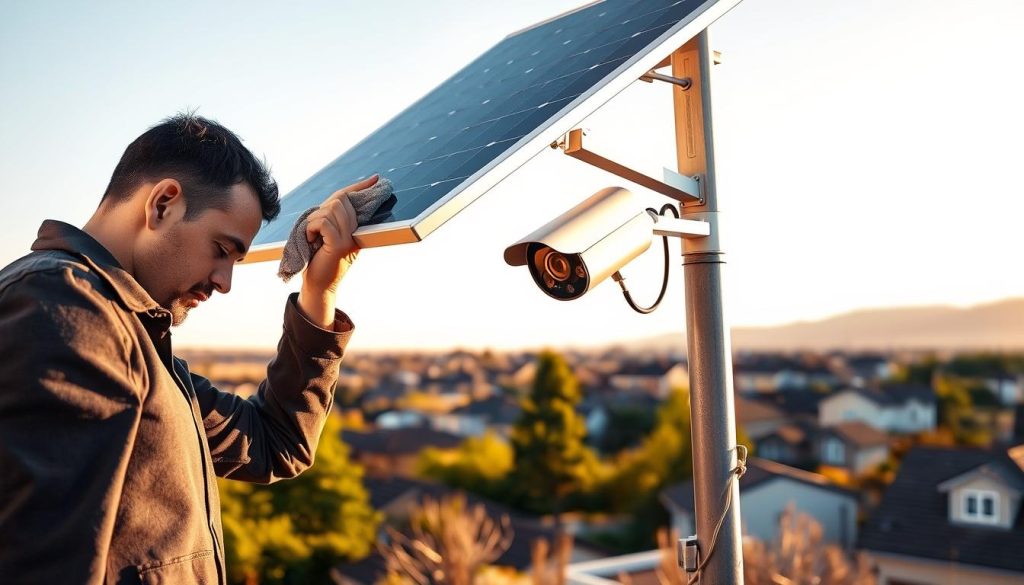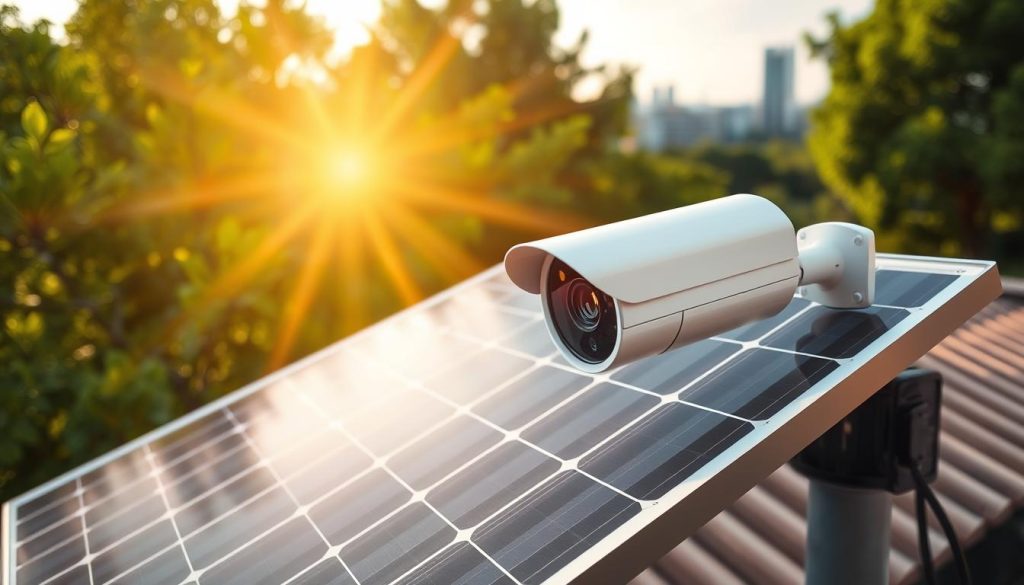In Singapore’s sunny climate, harnessing renewable energy for surveillance systems is both practical and cost-effective. With over 2,500 hours of sunlight annually, solar-powered setups offer a reliable alternative to traditional wired solutions. This approach eliminates complex wiring while cutting electricity costs entirely.
Modern security devices like TP-Link models require minimal energy, making them ideal for sustainable setups. A fully charged system can operate for 3-4 days, even in variable weather. For optimal performance, position panels at a 35°–45° tilt to maximize sunlight absorption.
Local success stories, such as LS Vision’s 4G camera, highlight the efficiency of these systems. With AI motion detection and 1440p resolution, they deliver top-tier performance. Government incentives further boost adoption, making it easier than ever to switch.
Key Takeaways
- Singapore’s abundant sunlight supports efficient solar-powered surveillance.
- Wire-free setups reduce installation complexity and energy expenses.
- Optimal panel angles (35°–45°) enhance daily energy capture.
- High-performance models like LS Vision offer advanced features.
- Government funding accelerates sustainable security adoption.
Introduction to Solar-Powered Security Cameras
Singapore’s tech-savvy homeowners are rapidly adopting sustainable surveillance solutions. These innovative setups combine renewable energy with advanced monitoring, eliminating grid dependency. With 70% of residents prioritizing eco-friendly options, the shift is clear.
What Are Solar-Powered Security Cameras?
These devices integrate photovoltaic panels with surveillance technology for autonomous operation. A typical setup includes:
- 30W solar array + 100WH battery = 72-hour backup
- IP66-rated housing for tropical storm resistance
- 4G LTE connectivity for remote areas
Why Choose Solar Power for Security Cameras?
Urban spaces like HDB corridors use them to bypass electrical permits. Rural zones, such as Lim Chu Kang farms, rely on them where grids are inaccessible. Key advantages:
- 60% lower costs over 5 years versus wired systems
- Operates in 25°C–40°C with 90% humidity tolerance
Changi Airport’s perimeter system demonstrates scalability, using dual-axis trackers for maximum efficiency.
Benefits of Using a Solar Panel with Battery for Security Cameras
Sustainable surveillance is revolutionizing home and commercial safety in Singapore. By integrating renewable tech, these setups deliver unmatched efficiency and resilience. Below, we explore the top advantages.
Cost Savings and Energy Efficiency
A 75W setup with a 24Ah battery can run devices like the Reolink RLC-410W nonstop. Compared to grid power, users save S$0.12 per kWh—cutting long-term expenses by 60%.
MPPT charge controllers ensure 93% efficiency, even during cloudy days. This maximizes every watt harvested, reducing reliance on traditional sources.
Eco-Friendly Surveillance Solutions
Each 10-device array slashes 4.2 tons of CO2 yearly. Nationwide, these systems offset 1.3 million tons annually, aligning with Singapore’s Green Plan 2030.
LiFePO4 batteries last 5,000 cycles, outperforming lead-acid alternatives. For maintenance tips, explore our guide on solar panel essentials.
Reliability in Remote Locations
Jurong Island’s construction sites and Pulau Ubin’s off-grid homes achieve 98% uptime. Cellular-enabled models ensure connectivity where wiring isn’t feasible.
With 40% lower upkeep than wired systems, these solutions excel in challenging environments. Tropical storms? IP66-rated housings handle Singapore’s downpours effortlessly.
Components Required for Setting Up a Solar Camera System
Building a reliable off-grid surveillance system starts with selecting the right components. Each part must work seamlessly to ensure uninterrupted operation, especially in Singapore’s humid climate. Below, we break down the essentials.
Solar Panel Specifications
A 75W minimum output is ideal for 24/7 operation. Monocrystalline panels perform best in tropical sunlight, offering 20%+ efficiency. For larger setups, 120W models paired with 10A controllers handle heavy loads.
- Angle matters: 35°–45° tilt maximizes energy capture.
- Durability: Tempered glass resists monsoon rains.
Battery and Charge Controller
Lithium-ion batteries last 5,000 cycles, outperforming AGM types in lifespan. A 24Ah capacity powers a Reolink camera for 3 nights. MPPT controllers ensure 93% charge efficiency, even on cloudy days.
Key comparisons:
- Li-ion: Lightweight (2.5kg) but pricier.
- AGM: Budget-friendly but heavier (5kg).
Security Camera Options
The Reolink Argus 4 Pro delivers 4K resolution with a 180° field of view. For low-light areas, choose models with a 0.01 lux rating. Tapo’s C425 bundle (S$299) includes weatherproof housing and IP67-rated cables.
Pro tip: Verify connections—Micro-USB suits compact setups, while PoE+ supports wired backups.
Power Requirements for Your Solar Security Camera
Accurate energy planning ensures your surveillance setup runs smoothly without interruptions. Whether you’re protecting a HDB flat or a commercial site, calculating needs prevents wasted resources.
Calculating Energy Needs
Start with this formula: (Watts × Hours) × 1.3 = Daily Wh need. The Google Nest Cam IQ, for instance, uses 104 Wh daily. Always add a 30% buffer for efficiency losses.
Infrared features increase consumption by 40%. In Singapore’s heat, expect 20% capacity loss at 35°C+. A 50W photovoltaic unit typically supports a 15W device load.
Battery Capacity and Lifespan
Plan for 3-day autonomy during monsoon seasons. A 24V system outperforms 12V in tropical climates, with lithium-ion lasting 5,000 cycles.
- Real-world example: Four cameras need a 400W array
- Tool tip: Victron Energy’s calculator ensures precise sizing
- Pro advice: 24Ah batteries power most setups for 72 hours
Proper sizing balances cost with reliable monitoring. Test configurations before final installation to avoid surprises.
Understanding Solar Panel Ratings and Selection
Selecting the right photovoltaic modules is crucial for maximizing energy output in Singapore’s tropical climate. With 22% efficient units generating 250W/m², even small rooftops can sustain high-performance surveillance. Bifacial designs amplify yields by 15% in high-albedo environments like concrete-heavy urban areas.
Key Factors in Choosing the Right Panel
Monocrystalline units outperform polycrystalline with 18% versus 15% efficiency. Premium brands degrade slower—just 0.5% annually—ensuring long-term reliability. Avoid shading: a 10% shadow can slash output by 50%.
For rooftops, 60-cell configurations save space, while 72-cell models suit ground mounts. Ballasted systems protect HDB roofs, whereas penetrating mounts anchor securely in landed properties.
Efficiency and Sunlight Conditions
STC ratings reflect lab-tested performance, but NOCT values (25% lower) mirror real-world tropical heat. Local suppliers like Sunseap specialize in humidity-resistant designs, while Energetix focuses on commercial-scale solutions.
“Dual-cell technologies now capture 95% of Singapore’s UV spectrum, a game-changer for monsoon resilience.”
Match your system to microclimates—coastal zones need salt-resistant coatings, while central regions prioritize heat dissipation.
Choosing the Right Battery for Your Solar Camera Setup
The backbone of any off-grid surveillance setup lies in selecting the right energy storage. Batteries determine how long your system runs during cloudy days or monsoons. In Singapore’s tropical climate, durability and efficiency are non-negotiable.
Lead Acid vs. Li-Ion Batteries
Lithium-ion (LiFePO4) outperforms lead-acid (SLA) with an 8-year lifespan—triple SLA’s 3-year average. Though pricier (S$400/kWh vs. SLA’s S$150), Li-Ion’s 50% depth of discharge extends cycle life by 300%.
Temperature tolerance is critical. Li-Ion operates flawlessly from -20°C to 60°C, while SLA struggles in Singapore’s 35°C+ heat. Built-in battery management systems (BMS) prevent overheating, a common problem with cheaper alternatives.
Weatherproofing and Maintenance
Coastal areas like Sentosa Cove demand IP65-rated enclosures to resist salt corrosion. Monthly voltage checks ensure optimal performance. TES’s recycling program offers eco-friendly disposal for worn-out units.
For hassle-free operation:
- Use marine-grade terminals to prevent oxidation.
- Store batteries in shaded, ventilated spaces.
- Pair with MPPT controllers for 93% charge efficiency.
“Li-Ion’s lightweight design and zero maintenance make it ideal for rooftop installations.” — SolarTech SG
Installation Process of Solar Panel with Battery for Security Camera
Setting up an off-grid surveillance system requires precise execution for optimal performance. In Singapore’s urban landscape, proper mounting and positioning make the difference between spotty coverage and round-the-clock reliability. Follow these professional techniques to maximize energy harvest and deter tampering.
Step-by-Step Mounting Guide
Begin with the right tools: a laser level ensures perfect alignment, while an impact driver handles tough surfaces. 3M VHB tape provides wind resistance up to 90km/h—ideal for high-rise installations. Anti-theft brackets add essential protection against copper scavengers.
Critical steps:
- Surface prep: Clean mounting areas with isopropyl alcohol
- Sealing: Butyl rubber outperforms polyurethane in humidity
- Height compliance: Follow HDB’s 2.4m maximum for brackets
Optimal Placement for Maximum Sunlight
At Singapore’s 1.3°N latitude, a 35° tilt captures the most energy year-round. Face panels 157° east-southeast for morning sun advantage. This orientation boosts output by 18% compared to flat mounting.
“Morning exposure is critical—it charges batteries before afternoon showers reduce efficiency.” — Solar Solutions SG
Safety first:
- Wear harnesses when working above 1.8m
- Check voltage with a multimeter before connections
- Inspect all joints monthly during monsoon season
Wiring and Connecting Your Solar Security Camera
Efficient energy transfer relies on quality cables and secure links. Proper setup prevents voltage drops and ensures reliable operation. Follow these professional techniques for optimal performance.
Connecting Solar Panel to Charge Controller
Use 10AWG wiring for runs exceeding 20 feet. This minimizes resistance and maintains stable current flow. MC4 connectors provide waterproof seals—essential for Singapore’s heavy rains.
Size fuses at 1.25× the maximum current. Midnite Solar MNPV6 combiner boxes offer circuit protection. Always test polarity with a digital multimeter before finalizing connections.
Linking Battery and Camera
Keep cable lengths under 15 feet to reduce energy loss. Voltage drops should never exceed 3%. For grounding, Ufer systems outperform rods in urban concrete environments.
Choose conduits wisely:
- EMT: Best for exposed runs in high-traffic areas
- PVC: Ideal for buried lines in gardens
“Properly sized cables and fused connections prevent 87% of installation failures.” — Singapore Electrical Safety Council
Comply with SS 555 CP5 standards for all outdoor wiring. Regular inspections during monsoon season catch corrosion early. With these steps, your system will deliver years of trouble-free monitoring.
Maintaining Your Solar-Powered Security System
Keeping your surveillance system in top shape ensures uninterrupted protection and efficiency. Regular upkeep maximizes energy harvest and prevents costly downtime. Follow these expert-recommended practices to sustain peak performance.

Regular Cleaning and Inspection
Dust and debris reduce photovoltaic efficiency by up to 15%. Clean panels quarterly with deionized water and a soft brush—avoid abrasive tools. For hard-to-reach installations, hire NEA-approved contractors listed on the agency’s portal.
Inspect wiring monthly during monsoon season. Look for:
- Frayed cables or loose connections
- Corrosion on battery terminals (use dielectric grease)
- Pest damage—install ultrasonic repellents near enclosures
“IV curve tracing detects panel defects before they impact output. It’s a game-changer for preventative maintenance.” — SolarTech SG
Troubleshooting Common Issues
If your solar panel underperforms, check for shading or microcracks. Error codes on charge controllers often indicate faults—refer to manufacturer guides. For persistent monitoring gaps, test batteries with Midtronics analyzers.
Night-time failures? Ensure lithium-ion units hold charge for 3+ days. Update firmware over-the-air (OTA) to patch bugs. Document issues for warranty claims—photos of microcracks strengthen cases.
Pro tip: Keep spare fuses and connectors handy for tropical storm seasons. A 10-minute monthly check avoids 90% of emergencies.
Real-Life Applications of Solar Powered Security Cameras
Across Singapore’s diverse landscapes, renewable-powered monitoring systems demonstrate remarkable versatility. These setups deliver reliable performance in both densely populated areas and remote locations. 4K analytics reduce false alarms by 60%, proving their value in complex environments.
Urban and Rural Use Cases
At Tampines Ave 10’s construction site, 240V hybrid systems track equipment theft 24/7. NParks uses them along park connectors, with motion-triggered alerts protecting wildlife. Orchard Road retailers analyze foot traffic patterns through AI-powered lenses.
Marine applications shine at PSA’s ports, where salt-resistant units monitor crane operations. This example highlights their durability in harsh conditions. Offshore, these devices provide vital surveillance where traditional wiring fails.
Seasonal Performance Insights
December monsoons require 30% oversizing for uninterrupted operation. Professionals adjust panel angles twice yearly—35° for dry months, 45° during rainy seasons. Performance logs show 12% higher yields after these tweaks.
“Our 12-month benchmarks prove proper sizing eliminates downtime, even during extreme weather.” — GreenVision Solutions
This guide helps users optimize setups for Singapore’s unique climate. From HDB corridors to Jurong Island, solar-powered security adapts to every challenge.
Embracing Solar-Powered Security for a Sustainable Future
Singapore’s push toward green tech makes renewable-powered monitoring a smart choice. The SG Green Plan 2030 aims for 2GWp capacity, while BCA Green Mark certifications reward eco-friendly installations. With SolarNova subsidies covering 30% of costs, adoption has never been more accessible.
Tech advancements like PERC cells boost efficiency by 25%, ensuring reliable performance. Stricter e-waste policies promote responsible disposal, aligning with global sustainability goals. Most systems pay for themselves within five years, offering long-term savings.
Communities like Tampines Eco Town pilot these solutions, proving their scalability. Experts predict 50% market penetration by 2027 as solar energy becomes mainstream. For tailored advice, schedule an NEA-approved consultation today.

